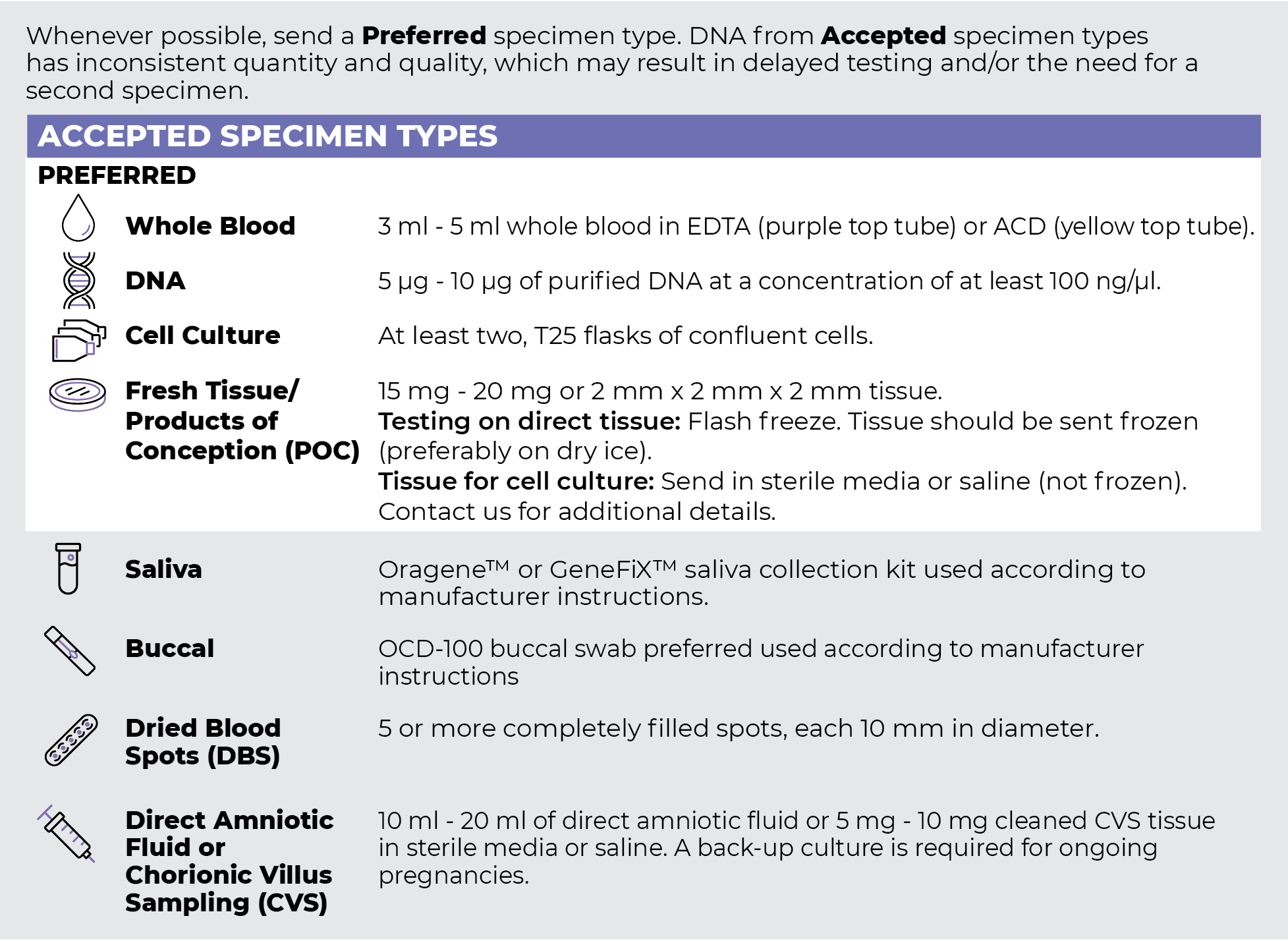Congenital Disorder of Glycosylation, Type IIm via the SLC35A2 Gene
Summary and Pricing 
Test Method
Sequencing and CNV Detection via NextGen Sequencing using PG-Select Capture Probes| Test Code | Test Copy Genes | Test CPT Code | Gene CPT Codes Copy CPT Code | Base Price | |
|---|---|---|---|---|---|
| 10645 | SLC35A2 | 81479 | 81479,81479 | $990 | Order Options and Pricing |
Pricing Comments
Testing run on PG-select capture probes includes CNV analysis for the gene(s) on the panel but does not permit the optional add on of exome-wide CNV analysis. Any of the NGS platforms allow reflex to other clinically relevant genes, up to whole exome or whole genome sequencing depending upon the base platform selected for the initial test.
An additional 25% charge will be applied to STAT orders. STAT orders are prioritized throughout the testing process.
This test is also offered via a custom panel (click here) on our exome or genome backbone which permits the optional add on of exome-wide CNV or genome-wide SV analysis.
Turnaround Time
3 weeks on average for standard orders or 2 weeks on average for STAT orders.
Please note: Once the testing process begins, an Estimated Report Date (ERD) range will be displayed in the portal. This is the most accurate prediction of when your report will be complete and may differ from the average TAT published on our website. About 85% of our tests will be reported within or before the ERD range. We will notify you of significant delays or holds which will impact the ERD. Learn more about turnaround times here.
Targeted Testing
For ordering sequencing of targeted known variants, go to our Targeted Variants page.
Clinical Features and Genetics 
Clinical Features
Congenital disorder of glycosylation, type IIm or early infantile epileptic encephalopathy-22 is characterized by early-onset epileptic encephalopathy. The major symptoms include early infantile onset intractable seizures, severe intellectual disability with lack of speech, hypotonia, hypsarrhythmia, microcephaly, dysmorphic features, recurrent infection and visual impairment. MRI shows cerebral and cerebellar atrophy, thin corpus callosum, and delayed myelination. Biochemical analysis in the biomarker transferrin may help the clinical diagnosis (Kodera et al. 2013. PubMed ID: 24115232; Ng et al. 2013. PubMed ID: 23561849; Westenfield et al. 2018. PubMed ID: 29907092).
Genetics
Congenital disorder of glycosylation, type IIm is inherited in an X-linked dominant manner and is caused by pathogenic variants in the SLC35A2 gene. SLC35A2 encodes solute carrier family 35 (UDP-galactose transporter), member 2. The UDP-galactose transporter selectively supplies UDP galactose from the cytosol to the Golgi lumen and is a critical component of glycosylation pathways such as N-glycosylation and O-glycosylation in eukaryotes. Pathogenic variants in SLC35A2 include missense, nonsense, small frameshift deletions, and a complex rearrangement. No large deletions/duplications have been reported. De novo pathogenic variants are common (Kodera et al. 2013. PubMed ID: 24115232; Human Gene Mutation Database).
Although most cases are female, affected males have been reported with somatic mosaicism, suggesting that a wild-type SLC35A2 allele may be required for survival. Female mosaicism has also been reported (Kodera et al. 2013. PubMed ID: 24115232; Ng et al. 2013. PubMed ID: 23561849; Westenfield et al. 2018. PubMed ID: 29907092).
Clinical Sensitivity - Sequencing with CNV PG-Select
Clinical sensitivity of SLC35A2 in a large cohort of patients with congenital disorder of glycosylation, type IIm relevant phenotypes is unavailable in the literature as most studies are case reports. Analytical sensitivity should be high.
Testing Strategy
This test provides full coverage of all coding exons of the SLC35A2 gene, plus ~10 bases of flanking noncoding DNA. We define full coverage as >20X NGS reads or Sanger sequencing.
Indications for Test
SLC35A2 sequencing is recommended for patients who are suspected to have congenital disorder of glycosylation, type IIm.
SLC35A2 sequencing is recommended for patients who are suspected to have congenital disorder of glycosylation, type IIm.
Gene
| Official Gene Symbol | OMIM ID |
|---|---|
| SLC35A2 | 314375 |
| Inheritance | Abbreviation |
|---|---|
| Autosomal Dominant | AD |
| Autosomal Recessive | AR |
| X-Linked | XL |
| Mitochondrial | MT |
Disease
| Name | Inheritance | OMIM ID |
|---|---|---|
| Congenital Disorder of Glycosylation Type IIm | XL | 300896 |
Citations 
Ordering/Specimens 
Ordering Options
We offer several options when ordering sequencing tests. For more information on these options, see our Ordering Instructions page. To view available options, click on the Order Options button within the test description.
myPrevent - Online Ordering
- The test can be added to your online orders in the Summary and Pricing section.
- Once the test has been added log in to myPrevent to fill out an online requisition form.
- PGnome sequencing panels can be ordered via the myPrevent portal only at this time.
Requisition Form
- A completed requisition form must accompany all specimens.
- Billing information along with specimen and shipping instructions are within the requisition form.
- All testing must be ordered by a qualified healthcare provider.
For Requisition Forms, visit our Forms page
If ordering a Duo or Trio test, the proband and all comparator samples are required to initiate testing. If we do not receive all required samples for the test ordered within 21 days, we will convert the order to the most effective testing strategy with the samples available. Prior authorization and/or billing in place may be impacted by a change in test code.
Specimen Types
Specimen Requirements and Shipping Details

ORDER OPTIONS
View Ordering Instructions1) Select Test Type
2) Select Additional Test Options
No Additional Test Options are available for this test.

